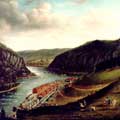|
In 1794, congress approved a bill "for the erecting and repairing
of Arsenals and Magazines." They chose Springfield, Massachusetts
as the site for the first national armory. President George Washington,
given wide discretionary powers in executing the legislation, then
selected Harper’s Ferry, Virginia, for a second national
armory.
Construction of the United States Armory and Arsenal at Harper’s
Ferry began in 1799. Three years later full-scale production of
arms commenced. Muskets, rifles and, after 1805, pistols were all
manufactured here. By 1810, annual production of arms averaged
about 10,000.
From the very beginning, however, the Harper’s Ferry Armory
labored under a deficiency of waterpower and charges of mismanagement.
After more than four decades of piecemeal funding and outright
neglect, plans for the site’s complete renovation were drawn
up in 1844. From 1845-54, seven new workshops were erected, 121
new machines were installed, the Armory Canal was enlarged, and
heavier millwork including the installation of new turbines was
completed. This extensive reconstruction created a more integrated
physical plant, whereby the flow of work from one stage of arms
production to another was greatly facilitated. These buildings
became known collectively as the U.S. Musket Factory. Compared
to 1802, when the Armory employed just 25 men, by 1859 the workforce
had grown to about 400.
With the Civil War there came destruction. When Virginia passed
an ordinance of secession on April 17, 1861, the Harper’s
Ferry Armory became an immediate target. Lt. Roger Jones of the
U.S. Army defended the Armory on the evening of April 18, 1861,
and set torches to the Armory and Arsenal buildings before retreating
across the Potomac River.
Further destruction came with Confederate occupation of Harper’s
Ferry in the spring of 1861. Southern forces confiscated the Armory’s
ordnance stock, machinery, and tools before burning many of the
remaining Armory buildings. By war’s end, only the Armory’s
fire engine and guard house remained intact. Today, the Armory
Grounds are almost completely covered by railroad track embankments.
Establishment of the U.S. Army Ordnance Department |